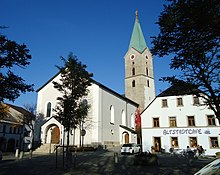St. Nikolaus (Bärnau)
The listed Roman Catholic parish church of St. Nikolaus is located in the northeastern area of the Upper Palatinate town of Bärnau (Pfarrgasse 2), it is consecrated to St. Nicholas of Myra .
history
The exact date the church was founded is unknown. In the parish register of 1326, no church is named in Bärnau. When Bärnau was raised to town in 1343, there was a chapel dedicated to St. Nicholas in the area of today's parish church. For this one was Frühmesser hired and endowed with the proceeds of some land (today is still the Flurname Engelmesserin present in Bärnau). In 1414 a pastor was mentioned in Bärnau and in 1438 a plebanus . In 1483 Ulrich Schiter, a member of the Weiden brotherhood, was named as pastor. From 1544 the Lutheran creed was introduced. In 1589 the pastor Thomas Otterer worked there. In 1658 a Catholic clergyman named Michael Hartmann was active again; Based on him, the list of the Catholic pastors of Bärnau continues to the present day. The parish of Hohenthan was also looked after from Bärnau in 1650. In 1681 a cooperator was also employed as a permanent assistant priest, until 1968 there are 80 cooperators. The parish belonged to the deanery of Eger.
On the map of the Flossenbürg office by Christoph Vogel from 1600, a church with a west tower can be seen in Bärnau, although the spire was still missing. After the city fire of 1685, this church was cremated and was later rebuilt in an expanded state. According to church accounts, this took place between 1733 and 1740. In 1733, Philipp Mühlmayer and Johann Georg Diller from Amberg were named as Bärnau builders. The crossing walls were now erected outside the previous church. In 1736, the nave was given a white ceiling with stucco decorations from the Bayreuth court stucco maker Hieronymus Andrioli. During the renovations, mass was held in the St. Michael cemetery church. In the town fire in 1778, the church was spared, but on March 25, 1800, it burned down again together with the tower.
It was not until 1808 that the construction of a new church began. The new main room now rests on six pillars. The church is a three-aisled, tiered hall church , it consists of a plastered solid building with a gable roof and a drawn-in, three-sided closed choir . The tower in the southern choir corner consists of unplastered ashlar masonry and is crowned with a pointed helmet .
Furnishing
In the major fire of 1800, the furnishings were destroyed by flames. For the newly constructed church is auctioned from the secular Franciscan Amberg three altars by 400 guilders from the Waldsassen monastery gave the former choir organ donated "according gracious resolution of Chur Princely State Directorate of Weiden" of 8 February 1805, the organ was now but replaced by a new one. The town fire of September 21, 1839 spared the church, but the church tower was destroyed and had to be rebuilt in 1843. In 1840 three more baroque altars were acquired from Bamberg Cathedral , which are still used as altarpieces today. They depict the martyrdom of St. Andrew , the Johann Evangelist and the healing of gout sufferers . They were painted by the Flemish baroque painter Oswald Onghers and are on the side walls in the chancel. The high altar is made in baroque and classical forms, the altarpiece shows Saint Nicholas distributing bread . The two side altars date from 1897.
More recent renovations took place in 1974–1983. The church is described as a typical example of the peasant baroque .
literature
- Christine Brunner-Hastreiter: Bärnau - a home book . Verlag der Stadt Bärnau, Bärnau 1972, pp. 212–215.
Web links
- Catholic parish church of St. Nicholas
- Bärnau town archive & Bärnau parish archive: St. Nikolaus parish church
Individual evidence
- ↑ Bärnau monument list
- ↑ Historical Atlas of Bavaria: Altbayern Series I, Issue 21: Tirschenreuth. Komm. Für Bayerische Landesgeschichte, Munich 1970, p. 262.
Coordinates: 49 ° 48 ′ 41.8 " N , 12 ° 25 ′ 53.4" E

